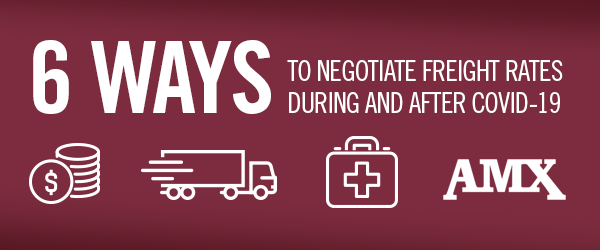[vc_row][vc_column][vc_column_text css=”.vc_custom_1652373829665{margin-bottom: 0px !important;}”]It’s always a challenge to negotiate freight rates. It’s made even more difficult as shippers aggressively shop for the best possible rate during the COVID-19 pandemic. It’s a reasonable take for short-term impact. Unfortunately, it could lead to higher freight prices across the board down the road.
Many logistics providers are struggling. More than 600 companies shut down in 2019, with insiders citing escalating insurance costs, equipment costs and a lack of drivers among the reasons. With more than 80% of logistics providers reporting decreased freight levels, the trend is expected to continue, even with many firms finding temporary support through government-issued payroll protection program (PPP) loans. Now, they’re being told to offer lower freight rates, or else…
Eventually, PPP support will end. And logistics providers will face a market with depressed rates, in part because of industry behemoths willing to sell services below their own costs. Many will go out of business. Others will have no choice but to raise freight rates for shippers as capacity re-tightens. There’s a better way. In fact, I present 6 better ways to work with your current, trusted freight company to ensure you get favorable pricing now — and in the future.
6 Tips to Improve How You Negotiate Freight Rates
1. More Transparency. Open and honest communication usually leads to stronger relationships. Quarterly Business Reviews can help your freight company understand the issues you’re facing, and give them time to find solutions to help resolve them. Even when not possible to meet in person, quick check-ins via phone or Zoom can open up critical lines of communication and ensure both parties are living up to their contractual responsibilities.
2. Right to Match. Nobody wants to lose money. Likewise, nobody likes to lose customers either. Let your freight partner know when you’ve found a lower rate. There are times when you’ll get a matching rate — from a company you already know and can trust to transport your freight quickly and safely.
3. Temporary Terms. Logistics providers understand that shippers are hurting, too. So they’re more willing to make short-term adjustments for the good of a long-standing relationship. Many firms may offer 45- or 90-temporary pricing and terms to help shippers during these difficult times. Those terms can be aggregated at years end to accurately depict the relationship over the entire year.
4. Negotiate Volume. Every negotiation has two sides, with multiple variables. Many logistics providers may be willing to meet lower price points — if they can offset it elsewhere. By offering other parts of your business, your dedicated freight partner can add more volume to compensate for the smaller margins.
5. Negotiate Flexibility. Everything is negotiable. For example, some trucking firms also have logistics arms of the business. To help keep costs consistently in check, perhaps use the logistics team to find lower rates with a wider fleet of available trucks and trailers.
6. Faster Payments, Lower Rates. The industry average for payment terms used to be 30 days. It has nearly doubled in recent years. Many firms may offer lower freight costs if they’re guaranteed payment sooner. All shippers need to do is ask if it’s a possibility.
A better partner, a more profitable future
In 2018, freight costs increased by as much as 30 percent in certain areas. That sort of drastic change sends ripples throughout the entire industry. I don’t think most in the industry want to repeat that sort of sudden price fluctuation.
You’ve found success with specific logistics providers in the past. As a result, you’ve stayed loyal when it’s possible. Even as freight rates become the paramount differentiator in which company you choose, your legacy providers might surprise you with how willing they are to work with you to balance the lowest rates with the best, most reliable service.
Give them a call. Contact them to find out.
Collins White, President of Logistics
[/vc_column_text][/vc_column][/vc_row]


